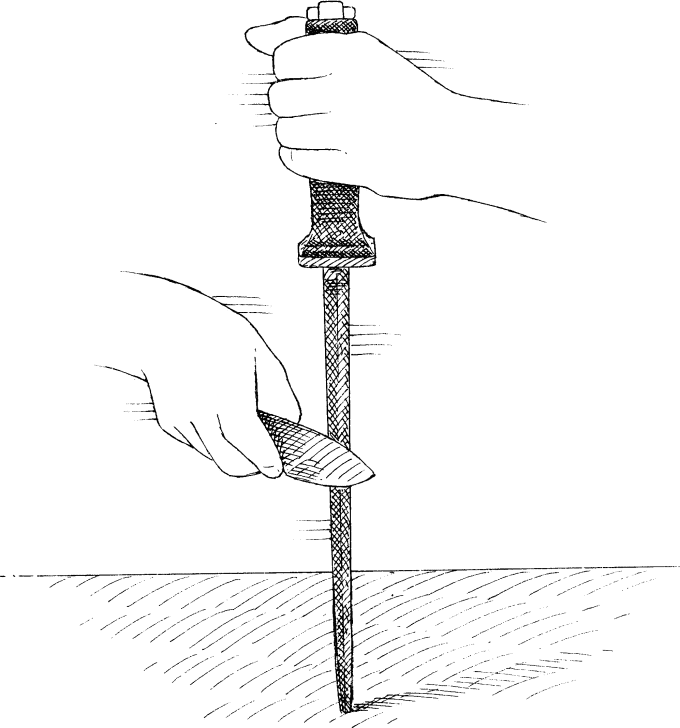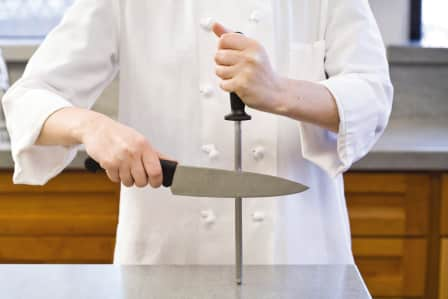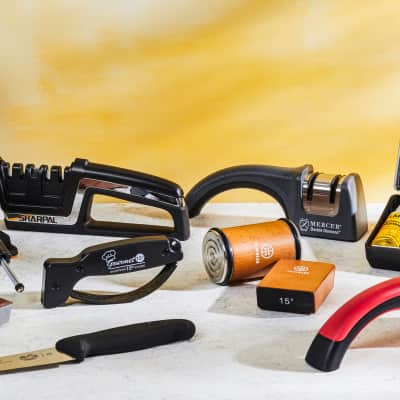Unpack a knife from the factory and the edge should be razor sharp. However, with use the edge will dull. The force of repeated cutting bends microscopic pieces of the blade to either side, making it harder to push the blade through the food, which in turn makes it feel dull to the user. A so-called sharpening steel—also called a honing rod—which is the metal rod sold with most knife sets, doesn’t really sharpen a knife, but rather hones the edge of a slightly dulled blade. Sweeping the blade along the steel realigns the edge so you don't have to sharpen as frequently.
How a Honing Rod Works
A honing rod, also sometimes called a "sharpening steel"—a bit of a misnomer since the steel "corrects" or "trues" the edge but does not really sharpen it—can help return the blade to its original condition by smoothing the edge.

Have You Heard?
Despite what many cooks believe, proper honing requires very little pressure. Listen to the steel as you work. A harsh rasping noise indicates that too much pressure is being applied. A quiet ring is a sign that a proper featherlike stroke is being used. Also, do not bang the knife against the finger guard since this can damage the edge. Perhaps most important is the angle between the blade and steel—15 degrees is perfect.
A knife that feels dull may need only a few light strokes on a steel to correct its edge and regain its sharpness. In fact, when cutting gristly meat, bony chicken, or other tough foodstuffs, occasional swipes on the steel may be called for. Wipe the knife clean before using it again.
How to Tell if Your Knife is Sharp

To determine if your knife needs sharpening, try the paper test. Hold a single copy sheet of paper. Place the heel of the blade at the top edge of the paper and slice downward, moving the knife through the paper from heel to tip. If the knife fails to slice cleanly, try honing it. If it still fails, it needs sharpening. (Learn more on how to sharpen kitchen knives.)
How to Use a Honing Rod
Although honing can be accomplished in any number of positions, the method described below makes it particularly easy to maintain the proper angle and is also quite safe since the blade is not moving toward either your hands or body. Throughout this motion, make sure to maintain a 15‑degree angle between the blade and the steel.

Step 1: To safely use a honing rod, hold it vertically with the tip firmly planted on the counter. Place the heel of the blade against the top of the steel and point the knife tip slightly upward. Hold the blade at a 15‑degree angle away from the steel.

Step 2: Maintaining light pressure and a 15‑degree angle between the blade and the steel, slide the blade down the length of the steel in a sweeping motion, pulling the knife toward your body so that the middle of the blade is in contact with the middle of the steel.

Step 3: Finish the motion by passing the tip of the blade over the bottom of the steel. Repeat this motion on the other side of the blade. Four or five strokes on each side of the blade (a total of eight to 10 alternating passes) should realign the edge.
You may also like:

How to Sharpen Kitchen Knives
A sharp knife is a fast knife, and a dull knife is an accident waiting to happen.
Learn More
How to Use a Whetstone
No other sharpener can hone and sharpen such a varied amount of knives.
Learn More
The Best Carbon-Steel Knives
Carbon-steel enthusiasts have long considered these knives sharper and more durable than stainless. But do they really perform better—and are they worth the upkeep?
Read Our ReviewMore from Cook's Illustrated

The Best Chef’s Knives for $75 or Less
Our longtime favorite chef's knife is sharp, capable, and comfortable to hold. But is it still the best?
Read Our Review
The Best Carbon-Steel Knives
Carbon-steel enthusiasts have long considered these knives sharper and more durable than stainless. But do they really perform better—and are they worth the upkeep?
Read Our Review
The Best Manual Knife Sharpeners
Keeping your kitchen blades sharp makes cooking easier, safer, and more enjoyable. The key is to get a good knife sharpener. We searched for a convenient and effective tool.
Read Our Review
Knife Sharpeners, 20-Degree (Conventional Western)
We tested nine sharpeners designed to maintain 20-degree (Western style) knives.
Read Our Review
How to Choose a Guard for Your Knife
Knife guards protect your knives—and your fingers—when you’re traveling or storing your knives in a drawer. But how do you find the right ones?
Learn More
Universal Knife Blocks
We tested 10 universal knife blocks priced from about $25 to just under $250, using them to hold our winning and Best Buy à la carte knife sets, each featuring a chef’s knife, serrated knife, paring knife, slicing knife, boning knife, and shears.
Read Our Review